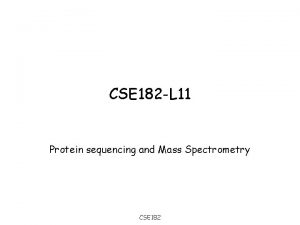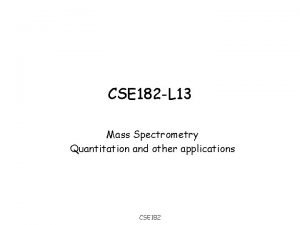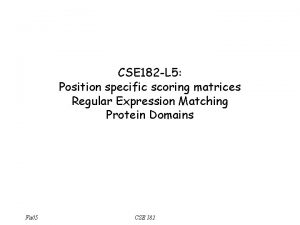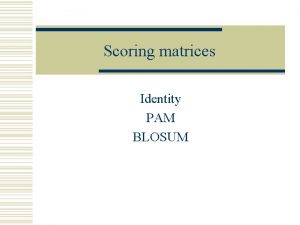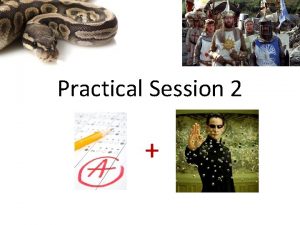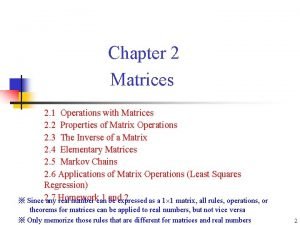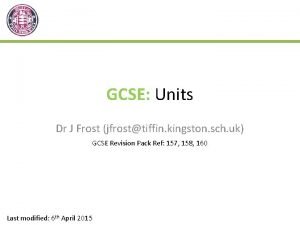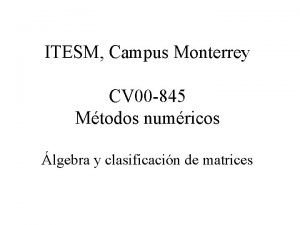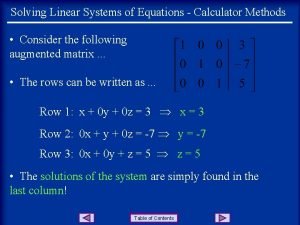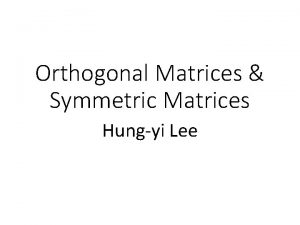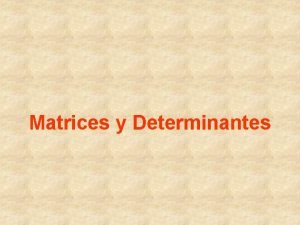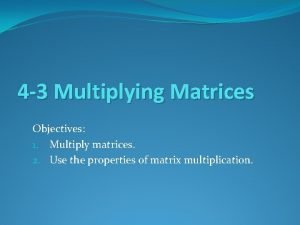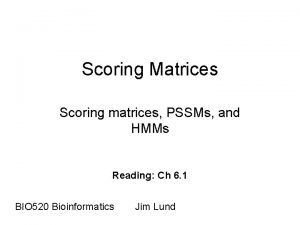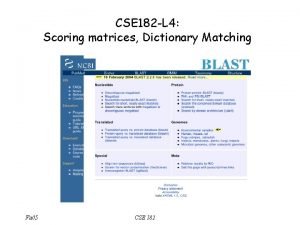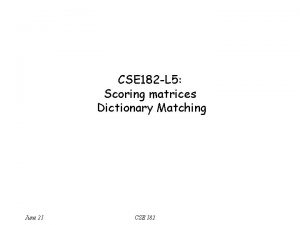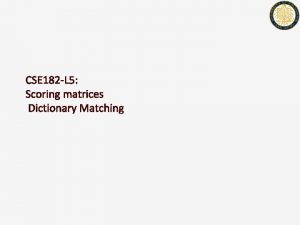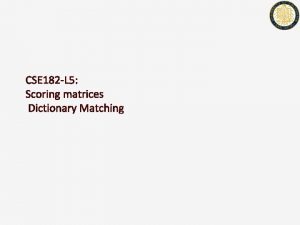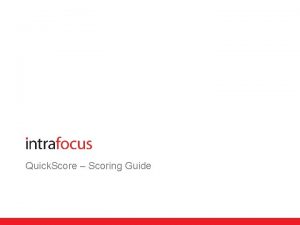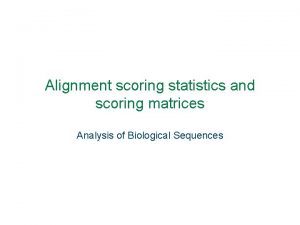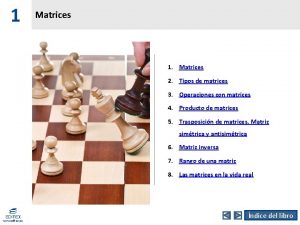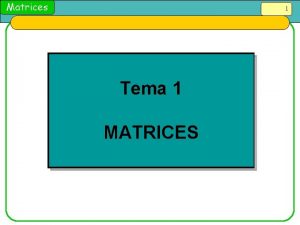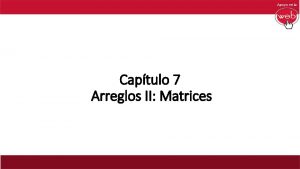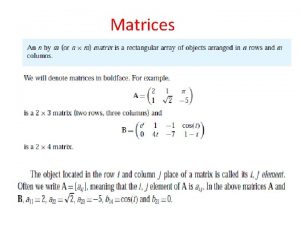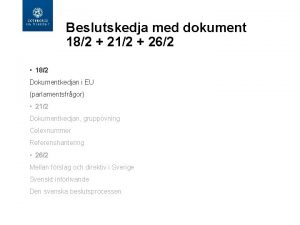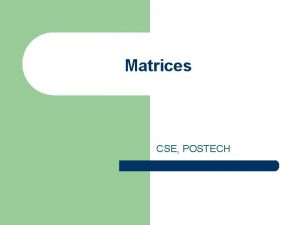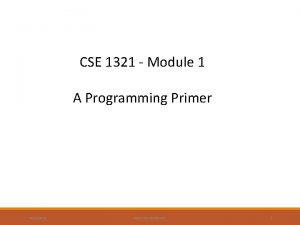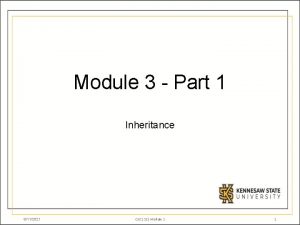CSE 182 L 4 Scoring matrices 9112021 CSE
























- Slides: 24

CSE 182 L 4 Scoring matrices 9/11/2021 CSE 182

Scoring Matrices • • We have seen that affine gap penalties help concentrate the gaps in small regions. What about substitution errors. Are all substitutions alike?

Scoring DNA • DNA has structure.

DNA scoring matrices • • • So far, we considered a simple match/mismatch criterion. The nucleotides can be grouped into Purines (A, G) and Pyrimidines. Nucleotide substitutions within a group (transitions) are more likely than those across a group (transversions)

Scoring matrices for DNA • Transversions are more heavily penalized than transitions.

Score function for proteins • • Suppose we are searching with a mouse protein. Blast returns proteins ranked by score – – – Top hit is to human Somewhere below is Drosophila Which one will you trust? hum 2 hum 88% 75% mus identity 50% identity 9/11/2021 dros CSE 182

It is all about expectations Pioneer Blvd. , Artesia 9/11/2021 CSE 182

Score function for proteins • • • Paralogs arise via gene duplications They rapidly diverge and take different functions The expected score is different when looking at human and mouse versus mouse and drosophila We need to score drosophila and mouse separately from human and mouse In this example, if the expectation is 33% identity, then a 50% identity is great. hum-paralog hum mus 75% identity 50% identity dros 9/11/2021 CSE 182

Frequency based scoring A B • • Our goal is to score each column in the alignment Comparing against expectation: – – • Think about alignments of pairs of random sequences, and compute the probability that A and B appear together just by chance PR(A, B) Compute the probability of A and B appearing together in the alignment of related sequences (orthologs) PO(A, B) A good score function? 9/11/2021 CSE 182

Log-odds scoring • How can we compute Poa|b? • 9/11/2021 We need good alignments, but…. CSE 182

Scoring proteins • Scoring protein sequence alignments is a much more complex task than scoring DNA – • • Not all substitutions are equal Problem was first worked on by Pauling and collaborators In the 1970 s, Margaret Dayhoff created the first similarity matrices. – – – “One size does not fit all” Homologous proteins which are evolutionarily close should be scored differently than proteins that are evolutionarily distant Different proteins might evolve at different rates and we need to normalize for that 9/11/2021 CSE 182

PAM 1 distance • Two sequences are 1 PAM apart if they differ in 1 % of the residues. 1% mismatch • PAM 1(a, b) = Pr[residue a substitutes residue b, when the sequences are 1 PAM apart] 9/11/2021 CSE 182

PAM 1 matrix • Align many proteins that are very similar – • • • Is this a problem? 1 PAM evolutionary distance represents the time in which 1% of the residues have changed PAM 1(a, b) = Pa|b = Pr(b will mutate to an a after 1 PAM evolutionary distance) Scoring matrix – S(a, b) = log 10(Pab/Pa. Pb) = log 10(Pa|b/Pa) 9/11/2021 CSE 182

PAM 1 • Top column shows original, and left column shows replacement residue = PAM 1(a, b) = Pr(a|b) 9/11/2021 CSE 182

PAM and evolutionary time • • Assume that mutations occur at a constant rate (molecular clock assumption). Therefore if 2 sequences are 1 PAM apart, they have diverged for some (say, N) years 9/11/2021 CSE 182

PAM distance • • Two sequences are 1 PAM apart when they differ in 1% of the residues. When are 2 sequences 2 PAMs apart? 1 PAM 2 PAM 9/11/2021 1 PAM CSE 182

Generating Higher PAMs • • • PAM 2(a, b) = ∑c PAM 1(a, c). PAM 1 (c, b) PAM 2 = PAM 1 * PAM 1 (Matrix multiplication) PAM 250 – – = PAM 1*PAM 249 = PAM 1250 b a = a PAM 2 9/11/2021 b c c PAM 1 CSE 182 PAM 1

PAM 250 Note: This is not the score matrix: What happens as you keep increasing the power? 9/11/2021 CSE 182

Scoring alignments • • To compute Pab, we need ‘high-quality’ alignments How can you get quality alignments? – – – Use SW (But that needs the scoring function) Build alignments manually Use Dayhoff’s theory to extrapolate from high identity alignments 9/11/2021 CSE 182

Scoring using PAM matrices • • • Suppose we know that two sequences are 250 PAMs apart. S(a, b) = log 10(Pab/Pa. Pb)= log 10(Pa|b/Pa) = log 10(PAM 250(a, b)/Pa) How does it help? – – – S 250(A, V) >> S 1(A, V) Scoring of hum vs. Dros should be using a higher PAM matrix than scoring hum vs. mus. An alignment with a smaller % identity could still have a higher score and be more significant 9/11/2021 CSE 182 hum mus dros

PAM 250 based scoring matrix • S 250(a, b) = log 10(Pab/Pa. Pb) = log 10(PAM 250(a, b)/Pa) 9/11/2021 CSE 182

BLOSUM series of Matrices • • • Henikoff & Henikoff: Sequence substitutions in evolutionarily distant proteins do not seem to follow the PAM distributions A more direct method based on hand-curated multiple alignments of distantly related proteins from the BLOCKS database. BLOSUM 60 Merge all proteins that have greater than 60%. Then, compute the substitution probability. – In practice BLOSUM 62 seems to work very well. – Blast Parameters 9/11/2021 CSE 182

PAM vs. BLOSUM • What is the correspondence? • PAM 1 PAM 2 • Blosum 62 • • Blosum 1 Blosum 2 PAM 250 9/11/2021 Blosum 100 CSE 182

END of L 4 9/11/2021 CSE 182
 Cse 182
Cse 182 Cse 182
Cse 182 Cse 182 ucsd
Cse 182 ucsd Amino acid substitution matrix
Amino acid substitution matrix Blosum62 scoring matrix
Blosum62 scoring matrix Script scoring
Script scoring Cessna 182 diesel
Cessna 182 diesel Flam 182
Flam 182 Cs 182
Cs 182 Tungsten-182
Tungsten-182 Engine on half power ahead - steer 182 degrees port side.
Engine on half power ahead - steer 182 degrees port side. Cs182 berkeley
Cs182 berkeley Love 182
Love 182 Nosotros commands
Nosotros commands Pg 167
Pg 167 Department order 182
Department order 182 Direct methods for sparse matrices
Direct methods for sparse matrices Properties of inverse matrix
Properties of inverse matrix Dr forst maths
Dr forst maths Clasificacion de matrices
Clasificacion de matrices Solving linear equations with matrices calculator
Solving linear equations with matrices calculator Orthogonal metrix
Orthogonal metrix Operaciones con matrices
Operaciones con matrices Matriz inversa metodo directo
Matriz inversa metodo directo Multiplying and dividing matrices
Multiplying and dividing matrices
